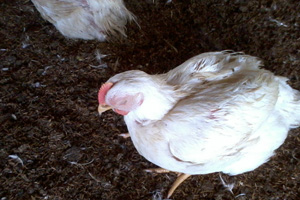Tackling avian pneumovirus in the field

Various strategies are carried out in tackling avian pneumovirus in broiler chickens. The multifactorial character of the disease, with a large effect on production and economics mainly due to secondairy bacterial infections, makes it a formidable opponent. Vaccination damps the damage, a field experience.
By G.A. Balestrin, V. Ferreira da Silva, J. S. Corella, veternarians at Hipra
Contact – javier.scorella@hipra.com
Respiratory problems in broiler chickens are a decisive factor in the productive and economic success of globally integrated companies. The main respiratory pathogens can be divided between bacteria and viruses, although the latter can only be controlled through the use of vaccines.
Among the viral agents most recognised at a global level, as a cause of production losses one can cite Newcastle disease, infectious bronchitis and avian influenza, while other agents such as aMPV have not been considered less important. Avian pneumovirus or avian metapneumovirus (aMPV) is a negative-sense single-stranded RNA virus, and a member of the subfamily Pneumovirinae within the family Paramyxoviridae (Gough, 2003). Only a single serotype has been identified to date, although four subtypes have been differentiated by the analysis of the nucleotide sequence of the (G) attachment glycoprotein (Juhasz & Easton, 1994) and neutralisation tests with monoclonal antibodies (Collins et al., 1993; Cook et al., 1993).
Secondary infections
The infection caused by aMPV favours the establishment and manifestation of secondary respiratory infections in broiler chickens and turkeys, as has been demonstrated with various respiratory pathogens (Naylor et al., 1992; Van de Zande et al., 2001; Marien et al., 2005; Van Loock et al., 2006). The control of the disease has been carried out through various strategies, as it is a disease of multifactorial character in broiler chickens. Nevertheless, in certain situations, the pressure of aMPV in the field makes vaccination necessary.
A field study was conducted to assess the efficacy of a live attenuated vaccine against aMPV, subtype B, chicken origin, strain 1062 (HIPRAVIAR SHS), in broilers with respiratory problems associated with aMPV of a Brazilian broiler farm (Sao Paulo state). The problem revealed itself as a respiratory disease that affected the upper respiratory tract between 28 and 35 days of age, with bacterial complications and weakening and mortality associated with the secondary bacterial infection. A vaccination plan was put in place as shown in Table 1.
Damage under control
The respiratory problems and the whole symptomology described above disappeared after the start of vaccination, and the zootechnical results showed an improvement in all areas. The values with distinct superscripts show significant differences at P ≤ 0.05 by unidirectional analysis of variance (ANOVA), while values with the same superscript do not show significant differences P >0.05. The mean mortality of all sheds in each batch was compared: the Before Vaccination data was obtained from the mean obtained from the two batches (BV1 6.23% and BV2 4.08%) giving a 5.15% mortality, while the mortality in the vaccinated batches was 3.05% for DV1 and 3.53% for DV2. An improvement in mortality of 36% between the mean of the unvaccinated batches and the vaccinated batches.
The Mean Daily Gain (Table 2) of the unvaccinated batches (57.21 and 55.09 g/day) showed a significant difference with the vaccinated batches: DV1 61.66 g/day and DV2 59.86 g/day. The mean weight at 41 days of the two vaccinated batches was increased by 170 g, implying a 7% improvement (Table 3). In consequence the feed conversion rate, standardised at 2 kg, improved from 1,841 in the no vaccinated batch to 1,636 in the vaccinated flock (Table 4).
Tailored approach
The incorporation of vaccines against aMPV into a vaccination programme should always be based on a reliable diagnosis of the agent causing the health problems, with clinical, serological and if possible molecular data. Nevertheless, given the productive model of broiler chickens – very short cycles and rapid rotation – there are many occasions in which an in-depth diagnosis is not carried out. If one adds to this the inadequate monitoring of aMPV in batches of broiler chickens, the research shows that this disease is mistaken for other respiratory processes on many occasions.
The use of HIPRAVIAR SHS in a broiler farm affected by aMPV leads to an improvement in the state of health of the batches, with significant positive repercussions for the zootechnical results, and so an improvement in the economic results. The vaccination plans for broiler chickens should be assessed in each broiler farm, in an individual manner, as the vaccination scheme will depend on the sanitary situation where the birds are to be vaccinated.
| The vaccination plan The comparative study was carried out on the same farm, in successive batches, with a total length of eight months (four batches, two without vaccination against aMPV and two vaccinated). The farm comprises of six sheds, with a capacity for 240,000 birds per cycle. A total of 917,000 birds were evaluated. The groups were designated Before Vaccination (BV), mean of the two batches before instituting vaccination with HIPRAVIAR SHS, and During Vaccination (DV), DV1 and DV2, two batches that were vaccinated as indicated in the Introduction. |













